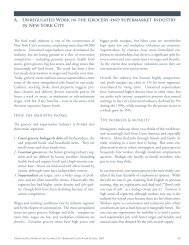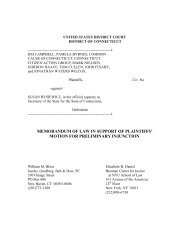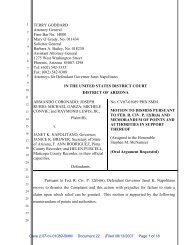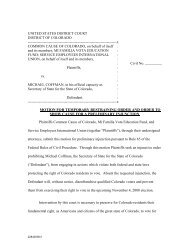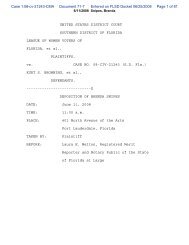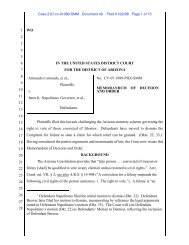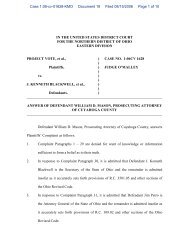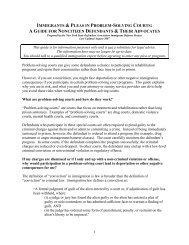Had advocates and researchers in New Jersey not been persistent in their ef<strong>for</strong>ts to overcome Sequoia’sresistance to a thorough and independent investigation of its machines, these flaws may never have cometo light. Indeed, even given the significant media attention that the incident received, other users of AVCAdvantage machines were unaware of the malfunctions that occurred in New Jersey. In March of 2008, aftercounty election officials in New Jersey had begun clamoring <strong>for</strong> an investigation of the machines’ behaviorin the February primary, officials in Montgomery County, Pennsylvania, an AVC Advantage county locatedless than fifty miles from the New Jersey border, told the Philadelphia Inquirer that they were unaware of theproblems that had occurred New Jersey. 179 Were Sequoia obligated to report any known flaws in its votingsystem to a federal oversight agency, these problems may have been revealed more expeditiously.14. Indiana, May 2006• • •Less than two weeks be<strong>for</strong>e the May 2006 primary election, voting machine manufacturer MicroVote admittedto election officials that the voting equipment it had sold to dozens of Indiana counties was uncertified, inviolation of state law. 180 The delay in obtaining certification caused a panic amongst county election officialswho faced the threat of legal action by the state if they used uncertified equipment in the primary. 181According to testimony and reports in the local media, while MicroVote continued to work toward certification,on April 22, ten days be<strong>for</strong>e the primary, it learned from the independent testing authority contracted to completeits certification that the company’s voting machines would allow some voters to cast votes <strong>for</strong> candidates whowould not represent them. The testing authority found that the company’s Infinity DREs, installed in 47counties across the state, allowed voters casting straight-ticket ballots in “split precincts,” where voters living inthe same precincts choose from different sets of candidates, to vote <strong>for</strong> the wrong set of candidates. 182In order to pass the certification process in time <strong>for</strong> the May 2 primary election, MicroVote opted to shut downthe machines’ straight ticket functionality altogether, allegedly at the advice of the independent testing lab. 183According to the Indianapolis Star, MicroVote worked in secret to develop a software update that wouldresolve the problem be<strong>for</strong>e the general election, when the straight-ticket function would be necessaryin several split precincts. 184 A sales representative <strong>for</strong> the company testified that MicroVote installedthe update on all Infinity DREs in the state without notifying the Indiana Election Commission,applying <strong>for</strong> certification only after the installation was complete. 185 Election officials only learned ofthe problem with the straight-ticket function when MicroVote applied <strong>for</strong> certification of this update,nearly four months after the company first became aware of the defect. 186Fortunately, the straight ticket function is not necessary in primary elections, but Indiana Election Coderequires that certified equipment be functional <strong>for</strong> both primary and general elections. 187 Perhaps moreimportantly in the minds of Indiana election officials, MicroVote appeared to have concealed in<strong>for</strong>mationfrom the Indiana Election Commission <strong>for</strong> months, and it is unclear what the company would have donehad they failed to come up with a solution be<strong>for</strong>e the general election. 188 Upon learning of the glitch and ofMicroVote’s prior knowledge of the problem, Indiana Election Commission chair Tom Wheeler said he was“disturbed by [the company’s] lack of candor.” 189 One year later, an administrative law judge fined MicroVoteover $360,000 <strong>for</strong> 198 violations of state election law occurring between October 2005 and the 2006 generalelection. 19024 | Brennan Center <strong>for</strong> Justice
the suboptimal structure ofthe voting system marketDiscussion of the need <strong>for</strong> regulatory re<strong>for</strong>m in the voting system market is incompletewithout mention of the market’s suboptimal structure. Purchasing a particular votingsystem essentially binds election officials to the vendor who sold them their system <strong>for</strong>many years to come. Because officials have extremely limited funds, they are unlikely toturn to a new vendor when problems arise: the systems (from precinct voting machinesto tally servers) are designed <strong>for</strong> matched components, which makes it impractical <strong>for</strong>officials to replace parts with those produced by a different vendor. Instead, they areeffectively <strong>for</strong>ced to buy an entirely new system and new machines <strong>for</strong> every polling place(an exceptionally expensive proposition). In addition to this cost, election officials bear theadditional burden of training election workers, poll workers and educating the public onthe new systems.At the same time, as a result of contractual constraints and because voting system vendorsgenerally have monopolies over the production of all replacement parts and exclusivecontrol over the firmware and software in each system, election officials will generallyremain extremely dependent upon the voting system vendor to address problems andensure that their systems are working smoothly. This includes programming their machines,providing them with software patches, diagnosing and fixing malfunctions, and providingreplacements when systems fail.Vendors often constrain election officials in more explicit ways. Many contractsexplicitly disclaim liability <strong>for</strong> damages resulting from problems that cause “data loss.” 191Furthermore, vendors have in the past threatened to sue election officials and others whopublicize machine flaws or independently investigate and test machines malfunctioningmachines. 192Election officials say this encourages them to keep quiet about machine malfunctions.Though understandable, this reluctance to publicize malfunctions contributes to thepossibility that election officials and watchdog groups remain in the dark about knownproblems. Consequently, it is essential to provide election officials with protections againstvendor retaliation. One solution is to allow election officials to post in<strong>for</strong>mation aboutknown problems on a nationwide database “semi-confidentially,” meaning that only otherelection officials and/or the agency charged with maintaining the database could viewthe official’s contact in<strong>for</strong>mation. Similarly, through statute, Congress or the states couldprovide monetary penalties and perhaps the creation of a private right of action againstvendors that retaliate and/or harass individuals or localities who report problems. 193 Lastyear’s announcement that the largest voting system vendors, Election Systems and Software(ES&S) and Premier (<strong>for</strong>merly known as Diebold), planned to merge raised concerns. Acentral worry was that the merger would leave election officials in an even weaker positionBrennan Center <strong>for</strong> Justice | 25
- Page 5: IV.A BETTER WAY TO TRACK AND ADDRES
- Page 11: 4. Pressure Vendors to Voluntarily
- Page 14 and 15: its newly established Voting System
- Page 16 and 17: iii.failures of the current system:
- Page 18 and 19: 2. Humboldt County, California, Nov
- Page 20 and 21: 4. Pulaski County, Arkansas, May 20
- Page 22 and 23: 7. Florida, June 2004According to t
- Page 24 and 25: Denise Lamb, who currently serves a
- Page 26 and 27: Ms. Poucher has stated that it “w
- Page 28 and 29: Sequoia identified four possible ca
- Page 32 and 33: elative to voting system vendors. A
- Page 34 and 35: or potential vulnerabilities by any
- Page 36 and 37: Finally, the Department of Justice
- Page 38 and 39: Provide Timely & Organized Access t
- Page 40 and 41: the CPSC may compel the manufacture
- Page 42 and 43: Civil Division of the Department of
- Page 44 and 45: C. Analogous RegimesCivil penalty p
- Page 46 and 47: Of course, adding these kinds of pr
- Page 49 and 50: v. conclusionVoting is the most imp
- Page 51 and 52: System Vulnerabilities: should incl
- Page 53 and 54: February2008September2004November20
- Page 55 and 56: November2006November2006ES&SiVotron
- Page 57 and 58: June 2008SequoiaOptech 400CCaliforn
- Page 59 and 60: March 2004March 2004DieboldAccuVote
- Page 61 and 62: February2008September2008PremierAcc
- Page 63 and 64: event of an overvote displayed a co
- Page 67 and 68: January 2008January 2008PremierAccu
- Page 69 and 70: November2004ES&SM650FloridaSupervis
- Page 71 and 72: October 2008February2008PremierAccu
- Page 73 and 74: February2008February2008October 200
- Page 75 and 76: 2004 AccuVote 2000ESNovember2008Nov
- Page 77 and 78: November2008November2008Hart InterC
- Page 79 and 80: February2008May 2006August 2004May2
- Page 81 and 82:
March 2008June 2009November2008Prem
- Page 83 and 84:
February2008November2006SequoiaAVC
- Page 85 and 86:
November2008SequoiaImageCastNew Yor
- Page 87 and 88:
November2004November2004UnilectPatr
- Page 89 and 90:
November2008November2008March 2008E
- Page 91 and 92:
May 2008April 2008November2006May 2
- Page 93 and 94:
2006 iVotronicThe Post & Courier re
- Page 95 and 96:
AccuVote TSR6; HartInterCiviceScan;
- Page 97 and 98:
November2006ES&S:iVotronicTexasHida
- Page 99 and 100:
November2003November2009November200
- Page 101 and 102:
October 2008October 2008May 2008ES&
- Page 103 and 104:
appendix c : dupage county election
- Page 105 and 106:
and resolve problems with certified
- Page 107 and 108:
49. E-mail from Carolyn Crnich, Cle
- Page 109 and 110:
95. Kleinberg, supra note 92.96. Ma
- Page 111 and 112:
143. Telephone Interview with Rokey
- Page 113 and 114:
187. Id. at 22.188. See Thomas, sup
- Page 115 and 116:
1801 (“[T]he Secretary shall init
- Page 117 and 118:
258. See United States Department o
- Page 119 and 120:
294. John Archibald & Brett J. Blac
- Page 121 and 122:
334. Jane Musgrave, Palm Beach Coun
- Page 123 and 124:
374. Glitch Keeps Fulton Voters Wai
- Page 125 and 126:
417. Joe Dejka & Chris Olson, A Lat
- Page 127 and 128:
457. Letter from Dave Byrd, Preside
- Page 129:
498. Lauren Glendenning, Voting Gli
- Page 132:
ennancenterfor justiceAt New York U



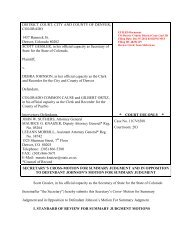
![Download the Letter [PDF] - Brennan Center for Justice](https://img.yumpu.com/50139248/1/190x245/download-the-letter-pdf-brennan-center-for-justice.jpg?quality=85)
